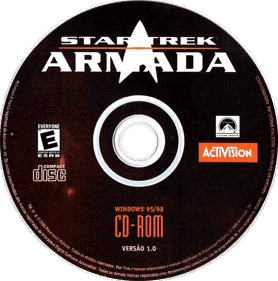Overview
Star Trek: Armada is a real-time strategy game set in space within the Star Trek universe, with four distinct races to command: the United Federation of Planets, the Klingon Empire, the Romulan Star Empire, and the Borg Collective, with several other races having minor appearances.
The game is set in the late 24th century, shortly after the Dominion War (thereby staying true to the series' tying of chronological events to air dates). While pacifying a system with rogue Dominion forces, captain Jean-Luc Picard of the USS Enterprise-E encounters a time-travelling Federation ship warning him of an imminent Borg invasion. While the Klingons battle amongst themselves, the Romulan covert intelligence agency, the Tal Shiar, discovers a very dangerous secret which can tip the balance of power in any one direction. The singleplayer campaign contains 20 missions split to 5 campaigns (4 for each race, plus one "hidden" epilogue campaign).
Although developed when few real-time strategies used 3D engines, Star Trek: Armada has numerous features and mechanics which make it distinct from other games in the genre. Ships and stations have two "health" layers: hull integrity and shields. Once the shields of an enemy ship are down, crew from a player-owned ship or station can be teleported to the target, and once the original crew has been killed off, the target is captured. The ratio of current crew as opposed to the maximum crew capacity dictates the object's rate of fire and self-repair rate. If a ship or station is left without a crew and there is none to replace it, it is considered derelict and will become uncontrollable until crewed again or destroyed, while neutral Ferengi marauders can tow derelict ships to an off-screen place for their own profit.
Aside from this, each ship and station has up to five systems which can be damaged randomly: shield generator, engines, life support, sensors, and weapons - once a ship's system is damaged, it will take time to repair unless sent to a shipyard for fast repairs. Also, most combatant ships have special weapons which can be researched and use up special weapon energy. In general, ships are divided to the following groups: construction ship, freighter, scout, destroyer, phaser cruiser, torpedo cruiser (Federation and Romulan are artillery), special weapon ship, battleship; Klingons and Romulans also have superweapon ships, while the Federation and the Borg have superweapon stations. Throughout the campaign, there are multiple "hero" ships commanded by the key characters, which differ from standard ships in their class by overall power, crew capacity, and size.
The Federation is an all-around balanced race, with both offensive and defensive special weapons and a superweapon station which freezes in time all ships and stations in a target area, leaving them vulnerable to attack. The Klingons focus on offense and have cheap but less durable ships (some of which with cloaking devices), with their superweapon ship able to create a destructive shockwave in a suicide attack. The Romulans specialize in stealth, equipping all combatant ships with cloaking devices and special weapons which spy on and/or disrupt enemy ships, while their superweapon ship creates a devastating ripple in the space-time continuum, also in a suicide attack. The Borg utilize massive, slow and expensive ships which are highly durable and powerful, and can capture (rather, assimilate) enemy ships more easily than other races, with their superweapon station allowing them to create transwarp gates (temporary wormhole-like passages) to counteract their low speed.
The environment is varied and important to the gameplay. Asteroids (some of which move in large circles) block access to certain parts of the map, wormholes provide fast travel from one area to another, nebulae give various bonuses or penalties to ships passing through them depending on the nebula type, black holes attract and destroy ships which travel near th
- Developers
- Activision
- Publishers
- Activision
- Platform
- Windows
- Genre
- Strategy
- Alternate Names
- No information available





























